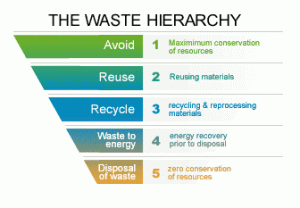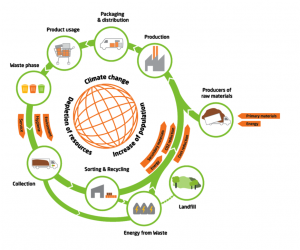Waste Management a Catalyst for a Circular Economy?
Waste is a term for unwanted materials, materials that are disposed of.
The origin of waste management lies in environmental policies. Poorly managed waste has an enormous impact on health, local and global environment, and economy; improperly managed waste usually results in down-stream costs higher than what it would have cost to manage the waste properly in the first place.
The policies gradually came into place out of protection of public health and environment, often after major incidents. Over time Regulation developed a preferential waste hierarchy: from avoiding (prevention-minimization), re-use, recycling, energy recovery to the least favored option disposal of waste.

In many upcoming economies with rapid urbanization there is still a tremendous need for sound waste management as (uncontrolled) landfilling is still the dominant practice. Building up regulation and expertise, financing the development of a basic waste infrastructure, setting up sound controls and dealing with the informal sector are still major challenges that require time to solve.
In more mature countries a decoupling has taken place between waste volume and economic growth. In parts of western Europa landfilling is less than 10% of waste treatment. Mainly driven by regulation, and supported by primary resource price increases, absolute volumes of residual waste destined for landfilling and incineration will shrink to favor recycling options.
Waste management increasingly becomes part of the resource and energy market.
By giving waste a second life as a resource or energy their customers reduce their impact in the value-chain, save cost and get access to recyclables or (renewable) energy. In the process a tremendous amount of green house gasses are avoided at a fraction of the cost of alternatives.
Where traditionally the emphasis has been on end-of-pipe regulation, with targets and standards becoming increasingly stricter, you can now expect that regulators, for example the European Union, move their targets increasingly on the production chain. Energy, climate, product and producer responsibility regulation will be tightened as well to create effects early in the value chain and not just at the end of the pipe. Examples are the eco-design directive, extended producer responsibility, green public procurement, eco-labels and targets for energy efficiency and climate related objectives.
What does it mean for waste managers? Quantity, quality and consistency of the secondary raw material will increasingly important for the resource customers of waste managers. As clients are seeking for ways to reduce waste and create value out of waste waste managers will have to facilitate them and create a volume-to-value strategy. New expertise in processing, business development, trading, setting up partnerships down the value-chain, risk-management, export regulation and understanding of its customers needs will be a pre-requisite to stay competitive. Waste managers in these parts of the world will have to adapt their strategy if they want to survive.
For waste managers recycling, if economically feasible, is often the preferred environmental solutions where-as in the circular economy recycling is the least desirable option.
In their recent book “Resource Revolution: How to Capture the Biggest Business Opportunity in a Century (New Harvest, April 2014) Stefan heck and Matt Rogers from McKinsey mention five principles that should be the first area a company should look at when thinking through its resource position.
– Finding opportunities to substitute away from scarce resources;
– Eliminating waste throughout the system, from production through end use;
– Increasing “circularity”- upgrading, reusing or recycling products;
– Optimizing efficiency, convenience, safety and reliability;
– Moving products, services and the process that develop or deliver them out of the physical world and into the virtual realm.
By closing the loop for their customers with effective collection systems, smart sorting, and recycling options and energetic valorization of the non recyclable fraction waste managers can be catalyst for the circular economy efforts of their clients. They can help for instance in the design-for-recyclability of the products of their customers. They can become (secondary) resource providers. They could even consider using their skill-set to play a role in repair-shops. For sure waste managers have to embark on a new journey with uncertain outcomes.

